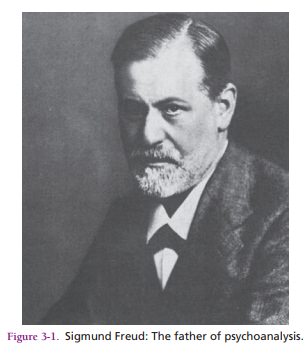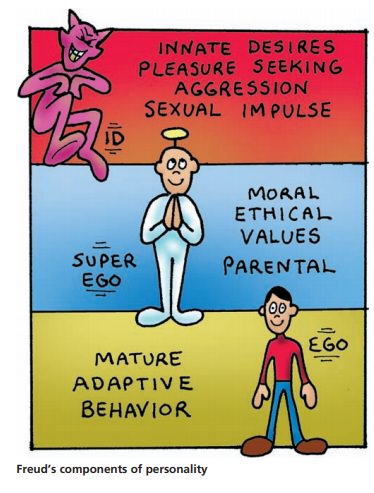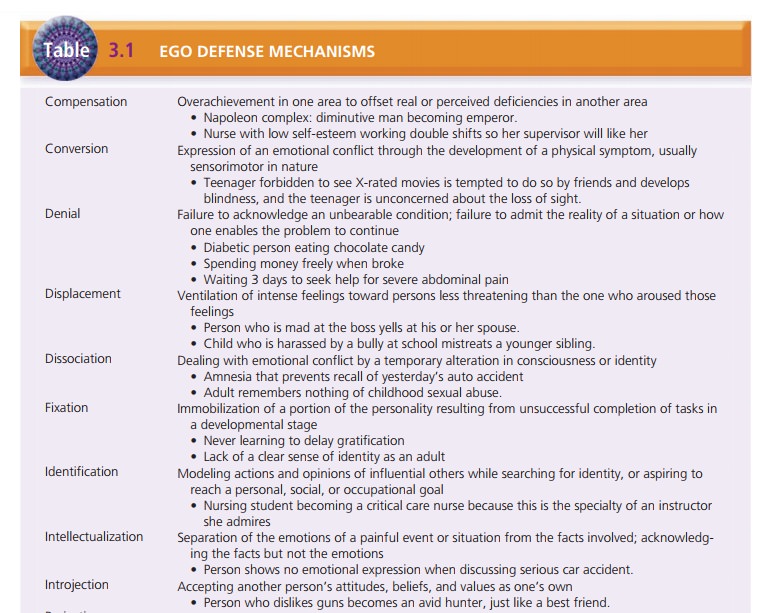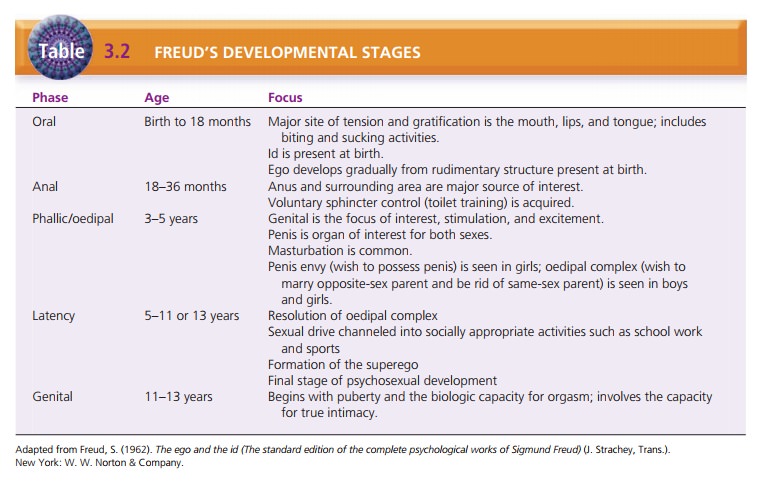Chapter: Psychiatric Mental Health Nursing : Psychosocial Theories and Therapy
Psychoanalytic Theories
Psychoanalytic Theories
Sigmund Freud: The Father of Psychoanalysis
Sigmund Freud (1856–1939; Figure 3.1) developed psychoanalytic
theory in the late 19th and early 20th cen-turies in Vienna, where he spent
most of his life. Several other noted psychoanalysts and theorists have
contributed to this body of knowledge, but Freud is its undisputed founder.
Many clinicians and theorists did not agree with much of Freud’s psychoanalytic
theory and later developed their own theories and styles of treatment.

Psychoanalytic theory supports the notion that all human behavior
is caused and can be explained (deterministic theory). Freud believed that repressed (driven from conscious
awareness) sexual impulses and desires motivate much human behavior. He
developed his initial ideas and explanations of human behavior from his
expe-riences with a few clients, all of them women who dis-played unusual
behaviors such as disturbances of sight and speech, inability to eat, and
paralysis of limbs. These symptoms had no physiological basis, so Freud
considered them to be the “hysterical” or neurotic behavior of women. After
several years of working with these women, Freud concluded that many of their
problems resulted from![]()
![]() childhood trauma or failure to complete tasks
of psycho-sexual development. These women repressed their unmet needs and
sexual feelings as well as traumatic events. The “hysterical” or neurotic
behaviors resulted from these unresolved conflicts.
childhood trauma or failure to complete tasks
of psycho-sexual development. These women repressed their unmet needs and
sexual feelings as well as traumatic events. The “hysterical” or neurotic
behaviors resulted from these unresolved conflicts.
Personality Components: Id, Ego, and Superego. Freud con-ceptualized
personality structure as having three compo-nents: id, ego, and superego
(Freud, 1923/1962). The id is the
part of one’s nature that reflects basic or innate desires such as
pleasure-seeking behavior, aggression, and sexual impulses. The id seeks
instant gratification, causes impul-sive unthinking behavior, and has no regard
for rules or social convention. The superego
is the part of a person’s nature that reflects moral and ethical concepts,
values, and parental and social expectations; therefore, it is in direct
opposition to the id. The third component, the ego, is the balancing or mediating force between the id and the super-ego.
The ego represents mature and adaptive behavior that allows a person to
function successfully in the world. Freud believed that anxiety resulted from
the ego’s at-tempts to balance the impulsive instincts of the id with the
stringent rules of the superego. The accompanying draw-ing demonstrates the
relationship of these personality structures.

Behavior Motivated by Subconscious Thoughts and
Feelings.
Freud believed that the human personality functions at three levels
of awareness: conscious, preconscious, and unconscious (Freud, 1923/1962). Conscious refers to the perceptions,
thoughts, and emotions that exist in the per-son’s awareness, such as being
aware of happy feelings or thinking about a loved one. Preconscious thoughts and emotions are not currently in the
person’s awareness, buthe or she can recall them with some effort—for example,
an adult remembering what he or she did, thought, or felt as a child. The unconscious is the realm of thoughts and
feelings that motivate a person even though he or she is totally unaware of
them. This realm includes most defense mechanisms (see discussion to follow)
and some instinc-tual drives or motivations. According to Freud’s theories, the
person represses into the unconscious the memory of traumatic events that are
too painful to remember.
Freud believed that much of what we do and say is motivated by our subconscious thoughts or feelings
(those in the preconscious or unconscious level of awareness). A Freudian slip is a term we commonly use
to describe slips of the tongue—for
example, saying “You look portly today” to an overweight friend instead of “You
look pretty today.” Freud believed these slips are not accidents or
coincidences but rather are indications of subconscious feelings or thoughts
that accidentally emerge in casual day-to-day conversation.
Freud’s Dream Analysis. Freud believed that a
person’s dreams reflect his or her subconscious and have
signifi-cant meaning, although sometimes the meaning is hidden or symbolic. Dream analysis, a primary technique
used in psychoanalysis, involves discussing a client’s dreams to discover their
true meaning and significance. For example, a client might report having
recurrent frightening dreams about snakes chasing her. Freud’s interpretation
might be that the woman fears intimacy with men; he would view the snake as a
phallic symbol, representing the penis.
Another method used to gain access to subconscious thoughts and
feelings is free association, in
which the therapist tries to uncover the client’s true thoughts and feelings by
saying a word and asking the client to respond quickly with the first thing
that comes to mind. Freud believed that such quick responses would be likely to
uncover subconscious or repressed thoughts or feelings.
Ego Defense Mechanisms. Freud believed the self, or
ego, uses ego
defense mechanisms, which are methods of attempting to protect the self and
cope with basic drives or emotionally painful thoughts, feelings, or events.
Defense mechanisms are explained in Table 3.1. For example, a person who has
been diagnosed with cancer and told he has 6 months to live but refuses to talk
about his illness is using the defense mechanism of denial, or refusal to
ac-cept the reality of the situation. If a person dying of cancer exhibits
continuously cheerful behavior, he could be using the defense mechanism of
reaction formation to protect his emotions. Most defense mechanisms operate at
the un-conscious level of awareness, so people are not aware of what they are
doing and often need help to see the reality.


Five Stages of Psychosexual Development. Freud based his theory of childhood
development on the belief that sexual energy, termed libido, was the driving force of human behavior. He proposed that
children progress through five stages of psychosexual development: oral (birth
to 18 months), anal (18 to 36 months), phallic/oedipal (3 to 5 years), latency
(5 to 11 or 13 years), and genital (11 to 13 years). Table 3.2 describes these
stages and the accompanying developmental tasks. Psychopathology results when a
person has difficulty making the transition from one stage to the next or when
a person remains stalled at a particular stage or regresses to an earlier
stage. Freud’s open discussion of sexual impulses, particularly in chil-dren,
was considered shocking for his time (Freud, 1923/1962).

Transference and Countertransference. Freud developed the concepts of transference
and countertransference. Transference occurs
when the client displaces onto the therapist
attitudes and feelings that the client originally experienced in other
relationships (Freud, 1923/1962). Transference patterns are automatic and
unconscious in the therapeutic relationship. For example, an adolescent female
client working with a nurse who is about the same age as the teen’s parents
might react to the nurse like she reacts to her parents. She might experience
intense feel-ings of rebellion or make sarcastic remarks; these reactions are
actually based on her experiences with her parents, not the nurse.
Countertransference occurs when the therapist
dis-places onto the client attitudes or feelings from his or her past. For
example, a female nurse who has teenage chil-dren and who is experiencing
extreme frustration with an adolescent client may respond by adopting a
parental or chastising tone. The nurse is countertransfering her own attitudes
and feelings toward her children onto the client. Nurses can deal with
countertransference by examining their own feelings and responses, using
self-awareness, and talking with colleagues.
Current Psychoanalytic Practice
Psychoanalysis focuses on discovering the
causes of the client’s unconscious
and repressed thoughts, feelings, and conflicts believed to cause anxiety and
on helping the cli-ent to gain insight into and resolve these conflicts and
anxieties. The analytic therapist uses the techniques of free association,
dream analysis, and interpretation of behavior.
Psychoanalysis is still practiced today but on a very limited
basis. Analysis is lengthy, with weekly or more frequent sessions for several
years. It is costly and not covered by conventional health insurance programs;
thus, it has become known as “therapy for the wealthy.”
Related Topics